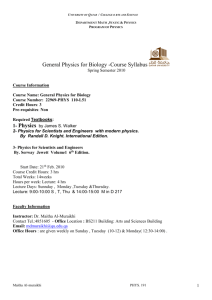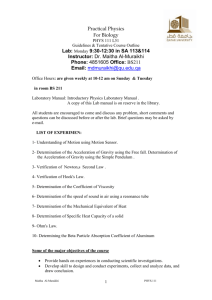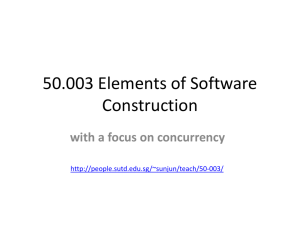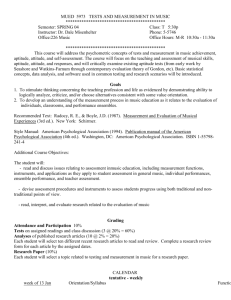General Physics I for Engineers Course Syllabus
advertisement
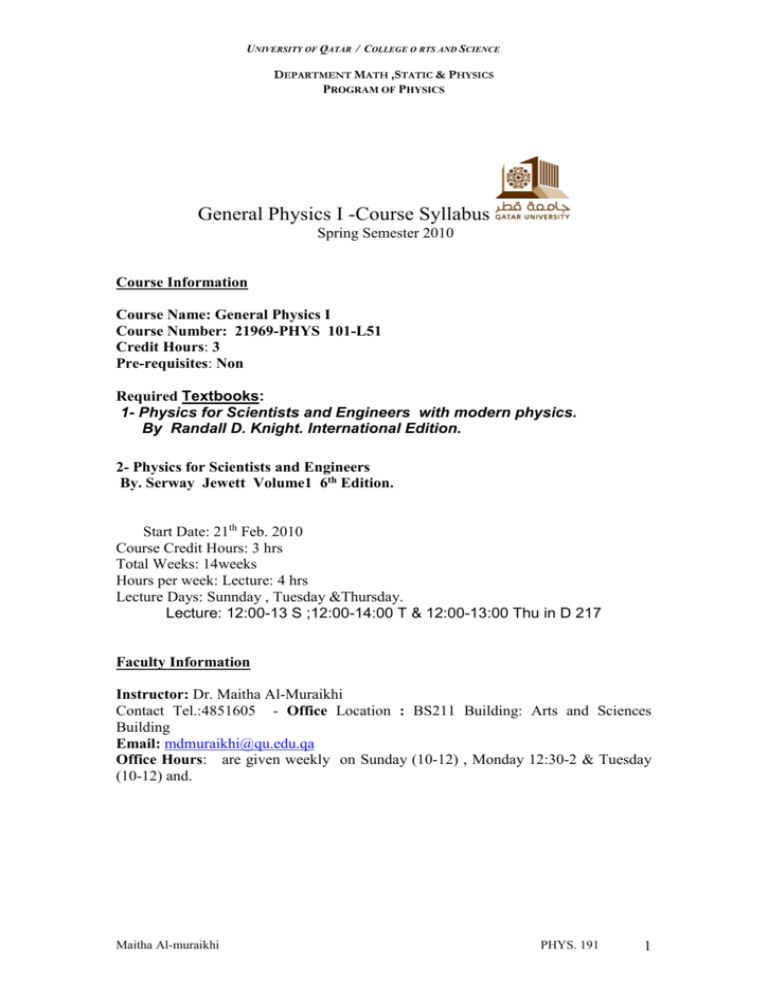
UNIVERSITY OF QATAR / COLLEGE O RTS AND SCIENCE DEPARTMENT MATH ,STATIC & PHYSICS PROGRAM OF PHYSICS General Physics I -Course Syllabus Spring Semester 2010 Course Information Course Name: General Physics I Course Number: 21969-PHYS 101-L51 Credit Hours: 3 Pre-requisites: Non Required Textbooks: 1- Physics for Scientists and Engineers with modern physics. By Randall D. Knight. International Edition. 2- Physics for Scientists and Engineers By. Serway Jewett Volume1 6th Edition. Start Date: 21th Feb. 2010 Course Credit Hours: 3 hrs Total Weeks: 14weeks Hours per week: Lecture: 4 hrs Lecture Days: Sunnday , Tuesday &Thursday. Lecture: 12:00-13 S ;12:00-14:00 T & 12:00-13:00 Thu in D 217 Faculty Information Instructor: Dr. Maitha Al-Muraikhi Contact Tel.:4851605 - Office Location : BS211 Building: Arts and Sciences Building Email: mdmuraikhi@qu.edu.qa Office Hours: are given weekly on Sunday (10-12) , Monday 12:30-2 & Tuesday (10-12) and. Maitha Al-muraikhi PHYS. 191 1 UNIVERSITY OF QATAR / COLLEGE O RTS AND SCIENCE DEPARTMENT MATH ,STATIC & PHYSICS PROGRAM OF PHYSICS Course Description This is the first course in the two-semester sequence of calculus-based introductory physics courses. The course is designed to meet the needs of student majoring in Physics, Chemistry, and Math. It is introductory courses in Newtonian mechanics with topics include: Vectors, motion in one dimension, motion in a plane, Newton's laws, work and energy, potential energy, momentum, Kinematics of rotational motion, dynamics of rotational motion, elasticity, and fluid mechanics. Course Objectives l. Provide a clear understanding of the basic concepts and integrating their knowledge in various disciplines of physics. 2. Develop positive attitudes towards seeking facts and scientific research. 3. Develop learning skills using. Experimental tools in physics lab. 4. provide a foundation for most of other natural sciences . Course matrix and Learning tasks Matrix of Objective and Outcomes Table of Education Outcomes: Knowledge, Skills, Values, and Assessments 1.Exams and Quizzes, 3.Reports. Educational Objectives This course aim to : 1. Provide a clear understanding of the basic concepts and integrating their knowledge in various disciplines of physics. Maitha Al-muraikhi 2.Homework, 4.Class activity, Intended Education Outcomes Upon completing this course of study, students should be able to demonstrated: 1.ability to comprehend and develop their knowledge in basic physics. 2.ability to deal with physical concepts numerically. Assessment s 1,2,3,4 1,2,4 PHYS. 191 2 UNIVERSITY OF QATAR / COLLEGE O RTS AND SCIENCE DEPARTMENT MATH ,STATIC & PHYSICS PROGRAM OF PHYSICS 2.develop positive attitudes towards seeking facts and scientific research. 3.develop learning skills using. Experimental tools in physics lab. Objectives Mechanics: To build up an understanding of fundamental physical principles. To build up a basic understanding of when and where specific physical principles apply. To build up an understanding of how physical principles are applied in every day life and engineering; To build up basic skills necessary for solving problems with practical applications by using physical principles; To equip students with the basic skills necessary for understanding of physical principles in terms of multiple representations: graphs, diagrams, equations. To familiarize students with the basic data analysis skills. Maitha Al-muraikhi 3. ability to defined some of the terms and concepts used in physics as a system ( mechanics ) 4.an integrated knowledge in various physical discipline. 1.attitudes of independence, ,organization, factories, communication, and life-long learning. 1,2,4 1.an ability to use devices as an educational tool. 2.creative and critical thinking. 3.the use of devices to visualize, mechanics . 4. experience in writing reports. 1,2,3,4 Outcomes 1,2,.3 3,4 Assessments In Mechanics -H.W. • Use kinematics equations to describe non-accelerated and accelerated motions of an object like a particle. • Apply Newton's laws of motion to solve linear dynamics problems. • Use the work-energy approach to solve dynamics problems involving conservative and nonconservative forces. • Apply momentum-impulse approach solve problems involving changing motions in due to elastic and inelastic collisions. • Apply rotational analogs of Newton's laws of motion to solve dynamics problems involving rotational motion. • Apply basic understanding of statics to simple particles and structures. -Quizzes -Computer Assignment -Online Assignments -Projects -Exams Topics Mechanics: Kinematics and Newton's Laws Particle Dynamics Momentum Work Energy and Energy Transfer Rotational Motion Static Equilibrium and Elasticity Fluid Mechanics: Bernoulli's Equation PHYS. 191 3 UNIVERSITY OF QATAR / COLLEGE OF ARTS AND SCIENCE DEPARTMENT OF MATH& PHYSICS PROGRAM OF PHYSICS Content Distribution Text book sections covered: week 1-8 Part I Chapter 1. Concept of Motion 3 2. Kinematics: the Mathematics of Motion 35 3. Vectors an Coordinate Systems 78 4. Force and Motion 97 5. Dynamics I : Motion Along a Line 122 6. Dynamics II: Motion in a Plane 151 7. Dynamics IIIA: Motion in A Circle 177 8. Newton’s Third Law 207 II 9. Impulse and Momentum 239 10. Energy 268 11. Work 304 III 12. Newton’s Theory of Gravity 343 13. Rotation of a Rigid Body 369 14. Oscillations 413 15. Fluids and Elasticity 444 9-11 12-15 Maitha Al-muraikhi PHYSICS 0-1052191 4 UNIVERSITY OF QATAR / COLLEGE OF ARTS AND SCIENCE DEPARTMENT OF MATH& PHYSICS PROGRAM OF PHYSICS Week # 1 Date Topic Feb.21 Introduction Feb.23 Motion in one dimention Reading Assignment Chapters 1,2,3 Feb.25 Mar.2 Mar.4 Mar.7 3 Homework assignment #2 Vectors Chapter 3 Quiz 2 Motion in One-Dimension and kinematics eqs. Free Falling Homework assignment #3 Two-Dimensional Motion with Constant Acceleration Mar.9 The Law of Motion Static &Dynamic equilibrium Mar.11 Newton’s Laws Mar.14 Homework assignment #1 Quiz 1 Feb.28 2 What is D Free body diagram Chapters 4,5 Homework assignment #4 Quiz 3 Chapters 5,6 Take home exam 4 Mar.16 More Application of Newton’s Laws Homework assignment # 3 Projectile Motion Quiz 4 Mar.21 5 Mar.23 Maitha Al-muraikhi Tangential and Radial Acceleration Chapters 7,8 Homework assignment # 4 PHYS.101 5 UNIVERSITY OF QATAR / COLLEGE OF ARTS AND SCIENCE DEPARTMENT OF MATH& PHYSICS PROGRAM OF PHYSICS Week # Date Topic Mar.25 Uniform Circular Motion Mar.28 Practice Mar.30 6 Apr.4 Reading Assignment What is D Practice problems before the MIDTERM FERST EXAM (1) Potential Energy and Energy Conservation Chapter 9 Apr.6 Homework assignment # 5 Quiz 5 Apr.8 7 Apr.11 Homework assignment 6 Rotational Motion Apr.13 Apr.15 8 9 Apr.18 Quiz6 Oscillation Motion Momentum and Collisions Apr.20 Practice Apr.22 Energy Apr.25 Chapter 10 Homework assignment 8 Quiz 7 Chapters 11,12 Homework assignment # 9 Practice problems before the MIDTERM( Work ----------------------- Apr.27 SECONDEXAM(2)----------------Apr.29 Work May.2 Newton’s Theory of Gravity 10 Maitha Al-muraikhi Chapter 14 PHYS.101 6 UNIVERSITY OF QATAR / COLLEGE OF ARTS AND SCIENCE DEPARTMENT OF MATH& PHYSICS PROGRAM OF PHYSICS Week # Date Topic Reading Assignment What is D May.4 May.6 Collissions 11 May.9 Conservation of Energy Chapter 13 Homework assignment # 11 May.11 May.13 Fluids and Elasticity May.16 Fluids and Elasticity Chapter 15 Quiz 8 12 Homework assignment # 11 May.18 Quiz9 May.20 Equation of Continuity 13 May.23 May.25 Equation of Continuity Bernoulli’s Equation y May.27 Practice Homework assignment # 12 Practice problems before the MIDTERM 14 May.30 Maitha Al-muraikhi PHYS.101 7 UNIVERSITY OF QATAR / COLLEGE OF ARTS AND SCIENCE DEPARTMENT OF MATH& PHYSICS PROGRAM OF PHYSICS Week # Date Topic Reading Assignment What is D Jun.1 Jun. Final Exam Final Exam 6 -Jun Monday 11:0013:00pm . First Periodical Test 0n Tuesday 30 – 3 -2010 Second Periodical Test on Tuesday 11-5 -2010 Final Exam on Sunday 6- 6- 2010 Method of teaching The methods of teaching will include: 1. Course documents, lectures 2. Interactive teaching 3. Take-home assignments Learning Resources and Media 1. 2. 3. 4. Lecture provided as power point presentations Oscillations and Mechanical Waves SHM, ppt animations. Exercises animations Each student was encouraged to: Daily use the internet to download some lectures and class problems and their solutions. Consult with the instructor during the office hours or by e-mail. Maitha Al-muraikhi PHYS.101 8 UNIVERSITY OF QATAR / COLLEGE OF ARTS AND SCIENCE DEPARTMENT OF MATH& PHYSICS PROGRAM OF PHYSICS Students evaluation - Grading System This course will be assessed by the active participation of the students during lectures, tests, quizzes, assignments and exams: Assessment Points 1. Quizzes & Take home exam 15 points 2. Exams First Exam :25 points Midterm = 25 points Final = 30 points 3. Presentations 5 points 4. Assignments Assessment Methods No points 1. Exams and tests Each exam (First, midterm and final) will consist of multiple choice or true/false questions and comprehensive problem’s solving. 2. Quizzes Approximately one quiz per week. Quizzes will be given announced. Each quiz will normally consist of one or two problems. Philosophy Mechanics is the branch of Physics dealing with the study of motion. No matter what your interest in science or engineering, mechanics will be important for you - motion is a fundamental idea in all of science. Mechanics can be divided into 2 areas - kinematics, dealing with describing motions, and dynamics, dealing with the causes of motion Maitha Al-muraikhi PHYS.101 9 UNIVERSITY OF QATAR / COLLEGE OF ARTS AND SCIENCE DEPARTMENT OF MATH& PHYSICS PROGRAM OF PHYSICS Kinematics deals with describing motions - after all, if you are going to study something (like motion) you had better be able to describe it completely, accurately, and consistently. In physics, you can describe an object's motion if you can tell where the object is going to be, how fast it will be going, and its direction of motion at any given time. For more specific expectations, a list of new terms and objectives is available. Newton's Laws are the "backbone" of dynamics - the study of the causes of motion. In Physics 1, the goal is to come to a relatively deep conceptual understanding of Newton's Laws, which is a very tall order. Students should be able to apply Newton's Laws to everyday situations - Course Instruction and Regulations: Student Responsibilities and Attendance Policies and Procedures Class attendance is compulsory. In accordance with University regulations, a student’s absence cannot exceed 25% of the total number (entire semester) of class meetings. If your absence rate exceeds 25%, including both excused and unexcused absences, you will NOT be allowed to take the final examination and will receive an ‘F barred’ grade for the course. If you are absent for the common mid-semester or final examination, stringent Department and University policies and procedures apply for make-up exams. Your course instructor can provide further information on this. In order for you to successfully complete this course, you must pay strict attention to your work and attendance. All homework assignments must be submitted to the instructor on time. No late assignments will be accepted. Students are responsible for obtaining material covered in class during their absence. Quizzes have no make up, so try not to miss any. Notify your instructors, in advance or in a timely manner, if you are unable to attend a class or submit a scheduled assignment. Using Mobile phones during lectures or exams is prohibited. Shut off your cell phone during class, any one uses mobile will be asked to leave the lecture room. Students are expected to participate actively in the class. Check your e-mail regularly. Prior to class, look over the section that will be covered. Maitha Al-muraikhi PHYS.101 10 UNIVERSITY OF QATAR / COLLEGE OF ARTS AND SCIENCE DEPARTMENT OF MATH& PHYSICS PROGRAM OF PHYSICS References RECOMMENDED TEXTBOOKS Halliday, Resnick &Walker , Fundamentals of Physics (Seventh Edition), volume 1 Young & Freedman, University Physics, Volume 1, 11th edition. L. C. McDermott, P. S. Shaffer, Tutorials in Introductory Physics, 1st edition Grant, I. S. W. R. Phillips The Elements of Physics, (Oxford University Press). Kleppner and Kolenkow An Introduction to Mechanics’, (McGraw-Hill) This course will be taught using Data show Power point facilities, involving Simulation of some Events and experiments through Internet . there may be some "growing pains". Hopefully we’ll learn together! Useful web sites: http://csep10.phys.utk.edu/astr161/lect/history/newton3laws.html http://csep10.phys.utk.edu/astr161/lect/history/newtonkepler.html http://csep10.phys.utk.edu/astr161/lect/history/velocity.html http://www.phys.virginia.edu/classes/109N/more_stuff/Applets/ProjectileMotion/jar applet.html http://www.ac.wwu.edu/~vawter/PhysicsNet/Topics/Vectors/VectorProducts.html http://mathforum.org/~klotz/Vectors/ Rubrics for the assignments, homework, presentations found on the Blackboard website. Maitha Al-muraikhi PHYS.101 11
